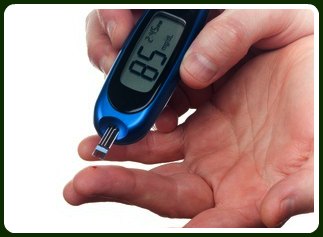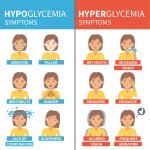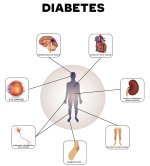What is Normal Blood Sugar?

You will have normal blood sugar if your body processes blood glucose efficiently. One of the main fuel sources for the cells in your body is glucose. Glucose is the sugar we refer to as blood sugar. Some glucose is always circulating in your bloodstream so that it can be available to any cell that might need it.
Your brain and your muscles are the biggest consumers of the sugar in your blood. But before most of the cells in your body can use glucose, it must first be transported out of your blood and into the cell that needs it. Insulin is the hormone that makes this happen.
Insulin is crucial to having normal blood sugar because without it, it doesn’t matter how much glucose is circulating in your blood, most of your cells will not be able to use it. This is why a lack of insulin is a huge problem… if the sugar in your blood isn’t taken into your cells, it will build up to dangerously high levels which damages your organs or could cause death.
How Normal Blood Sugar is Measured
Normal blood glucose can be measured a couple of ways.
- A1C Test
- Blood Sugar Self Test using a Glucose Meter
- Urine Test
An A1C test will reflect your average blood sugar level for the past two or three months. A blood sugar test using a glucose meter will tell you what your blood sugar level is currently and can vary widely based on how long it has been since you ate last, among other things. Urine tests for glucose are not as accurate as blood glucose tests and only should be used when blood testing is impossible.
The American Diabetes Association suggests the following normal blood glucose targets:
- A1C: 7% or eAG of 154 mg/dL
- Blood Test result of 70-130 mg/dL before a meal
- Blood Test result of less than 180 mg/dL 1-2 hours after a eal
However we believe that the following blood sugar ranges are optimal based on combining information from a variety of sources like the International Diabetes Federation, the American Diabetes Association, and the National Institute for Clinical Excellence (NICE).

But wait, are the above normal blood sugar levels truly optimal??
The above blood sugar levels are those that are recommended by most doctors. However, Professor J.S. Christiansen presented some illuminating research ath the European Association for the Study of Diabetes conference in September 2006 that shows that the normal ranges that most doctors use are really higher than normal.
The study was conducted with the use of a continuous glucose monitoring system (CGMS) which is a small computer attached to a probe. The probe is inserted under the skin where it samples the blood sugar every few minutes for a period lasting from several days to several weeks.
The data collected during the study showed that the median fasting blood glucose concentration for normal subjects remained flat at 80 mg/dL throughout the night. After a high carbohydrate meal, their blood sugar rose to a median value near 125 mg/dL for a brief period, about 45 minutes after they ate. Then for all but the subjects with the highest readings, blood sugar dropped back down under 100 mg/dL by one hour and fifteen minutes after eating. By one hour and forty five minutes after eating it dropped back down the 85 mg/dL.
Using this data, the optimal blood sugar range for normal blood sugar are:

Your healthy blood glucose range may vary from what is typically considered normal based on a number of factors:
- If you have diabetes and for how long
- Your age
- Certain medical conditions
- Genetic heritage
- Individual patient considerations like hypoglycemia unawareness
Should You Check to See If You Have Normal Blood Sugar?
You may want to have your blood sugar tested if you experience any of the symptoms of high or low blood sugar. You should also check your blood sugar levels if you are pregnant or want to get pregnant since both are affected by having blood sugar levels that are too high or too low. If you suspect or have been told that you have metabolic syndrome or are insulin resistant.
You should be regularly checking your blood sugar if:
- You know you have blood sugar issues
- You are taking insulin
- You suspect or you have been told you have insulin resistance or metabolic syndrome
- You have had low blood glucose levels in the past without the usual warning signs (hypoglycemia unawareness)
- You have had high ketone levels in your urine due to high blood glucose levels
Normal Blood Sugar Testing
In addition to the A1C test mentioned above, some other tests your doctor is likely to perform to determine if you have normal blood sugar are:
- Fasting blood glucose test
- Glucose tolerance test
A fasting blood glucose test measures your blood sugar levels after at least eight hours of fasting. Typically is a fasting glycemia test is done first thing in the morning. You can perform this test on your own using a blood glucose monitor and testing your own blood first thing in the morning.
A glucose tolerance test involves drinking a prescribed amount of sugar (usually an orange syrup) and then being tested at half hour intervals for two hours to see how effectively your body metabolizes sugar. If after two hours your blood sugar level is under 140 mg/dL (7.8 mmol/L) then you are considered normal. You will be considered to have impaired glucose metabolism if your results are between 141 mg/dL and 200 mg/dL (7.9 mmol/L and 11.1 mmol/L). You will be likely be given a diagnosis of diabetes if your blood glucose remains over 200 mg/dL (11.1 mmol/L) two hours after you drink the sugar solution.
- Normal: under 7.8 mmol/l (140 mg/dl)
- Prediabetes or Impaired Glucose Tolerance: 7.9 to 11.1 mmol/l (141 to 200 mg/dl)
- Diagnosis of diabetes: more than 11.1 mmol/l (200 mg/dl)
As mentioned before, you can also buy a blood sugar monitor and test your own blood sugar:
- Upon waking
- Before meals
- After meals
…to get an idea regarding how the food you normally eat is affecting your blood sugar levels. If you haven’t already been diagnosed as diabetic but your blood sugar is outside of the optimal range, it is likely that they things that you are eating is causing your blood sugar to be outside of the normal blood sugar range. A diet high in processed food and carbohydrates is known to cause blood sugar levels to fluctuate, both causing blood sugar spikes and hypoglycemia.
Maintaining a normal blood sugar level is critical to good health and longevity. According to the International Diabetes Federation, a normal blood sugar range for people without diabetes and who are not fasting should be between 82 mg/dL (4.4 mmol/L) and 110 mg/dL (6.1 mmol/L) with 82 mg/dl being optimal. However, you blood sugar levels can vary widely depending on what you eat as well as other health factors like exercise, fatigue, illness, adrenal health and how hydrated you are. Because what you eat is really the biggest factor that effects your blood sugar levels, normal blood sugar ranges are reported based on how long it has been since you have eaten.
For the majority of healthy individuals, normal blood sugar levels are as follows:
- Fasting blood sugar levels should be between 70 and 100 mg/dL (3.9 to 5.6 mmol/L )
- Optimal non fasting glucose level in humans before a meal is less than 100 mg/dL (5.5 mmol/L )
- When operating normally the body restores blood sugar levels to a range of 4.4 to 6.1 mmol/L (82 to 110 mg/dL) within two hours after eating
- Shortly after a meal the blood glucose level may rise temporarily up to 7.8 mmol/L (140 mg/dL)



New! Facebook Comments
What do you think? Share your thoughts below...